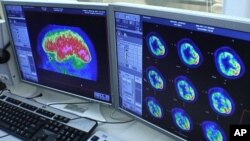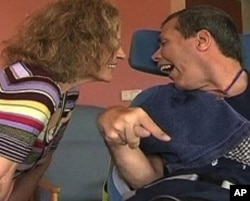For more than two decades a Belgian man named Rom Houben was misdiagnosed as being in a vegetative state, following a car accident. Then doctors discovered through a brain scan that he was conscious and possessed normal brain function.
At first it seemed the 46-year-old Belgian could communicate with tiny movements of his fingers as an aide guided his hand on a keyboard. But experts later discounted that. Doctors say Houben has awareness of self and his surroundings, but is unable to control any of his movements, even of his eyes, in order to communicate.
Now, research from Belgium and Britain suggests that patients like Houben who were misdiagnosed as vegetative or minimally conscious might someday, with new technologies, be able to communicate directly from the brain. The findings could change the diagnosis and treatment of seemingly unresponsive patients, of whom there are an estimated several hundred thousand in the United States and Europe alone.
In the study, 54 apparently unresponsive patients were placed in magnetic resonance imaging scanners, and told to visualize two scenes that activate separate parts of the brain: playing football or walking through the house. In five of the 54, those scenes activated and lit up the same brain areas as in normal patients. One patient then went on to correctly answer five out of six yes-or-no questions about his own life -- by visualizing football to communicate 'Yes,' or walking through the house for 'No.'
"It opens a new era where we need to prepare for what we are going to do with this technology,” said Steven Laureys of the University of Liege in Belgium, one of the researchers. ‘We can ask big questions here. This will have major medical, ethical and legal impact.”
Another leading researcher in the field, Dr. Nicholas Schiff of New York's Presbyterian Weill Cornell Medical Center, says the study will lead to better diagnostic tools, using brain scans to identify the minority of patients with the potential to communicate.
“Whether they then could harness some sort of communication device and establish systematic communications, whether they could then initiate communication, these are all these unknowns,” he said. “But we've found when patients can do that, it makes a very big difference for them, and I think these are going to be very big health-care delivery issues." One major issue, he observes, will be the right of such patients to direct their own care. Some who exist in this “locked-in” state may ask to die.
The new findings do not apply to patients who are brain-dead, whose bodies are kept alive by machines. And Schiff notes that heart attack and stroke victims who suffered widespread brain-cell death from oxygen loss are unlikely to be found to be conscious. But the study offers hope to a minority of brain-injured patients who might one day, as imaging technology evolves, be able to communicate directly from their brains.







